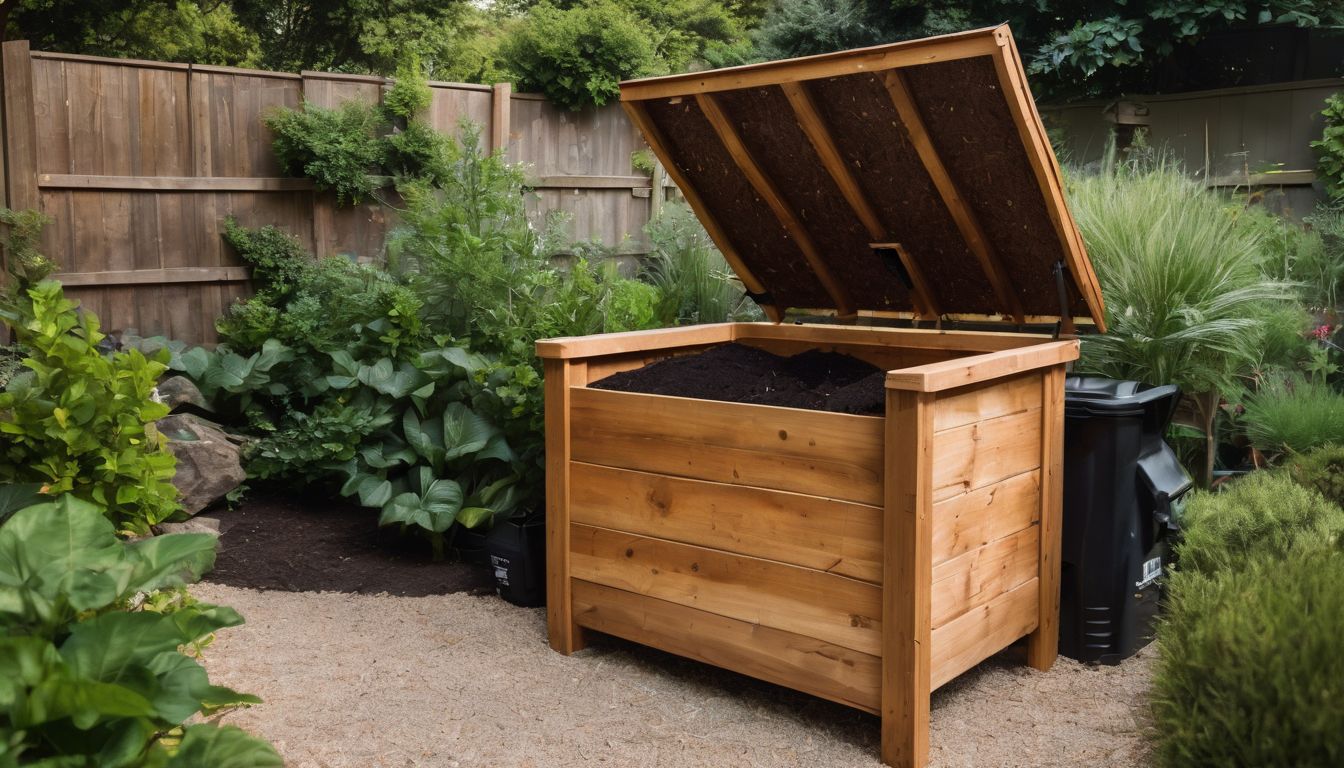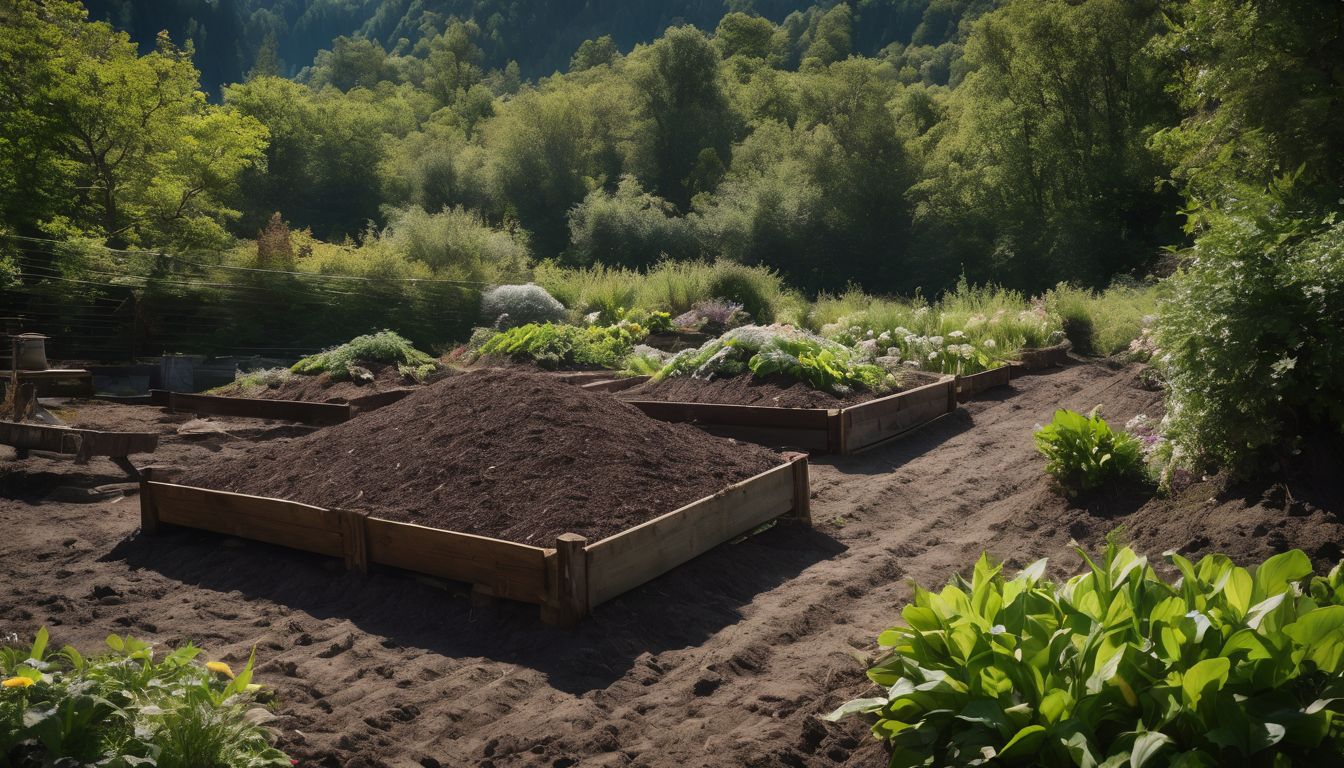Are you tired of looking at your dull, lifeless lawn? Compost is a garden goldmine that enriches the earth and breathes new life into your grass. This blog will guide you in transforming your patchy green into a lush carpet with nature’s conditioner – compost.
Dive in for greener pastures!
Key Takeaways
- Compost is made from decomposed organic matter, which enriches soil with vital nutrients like nitrogen, phosphorus, and potassium.
- Applying compost to your lawn improves soil structure, helps retain moisture and promotes a healthy ecosystem underground without the use of chemical fertilisers.
- Grass clippings and manure can also be added as natural nutrients to boost lawn health; they should be used carefully to avoid smothering grass or introducing pathogens.
- The best time to apply compost is during early spring or late fall at a depth of 1/4 to 1/2 inch for optimal root growth and nutrient absorption.
- Regular application of compost contributes to sustainable gardening by lowering dependency on synthetic additives while nurturing more robust plant growth.
What is Compost?
Compost is organic matter that has been decomposed and recycled as a natural fertiliser and soil conditioner. It improves soil structure, provides essential nutrients for plant growth, and helps retain moisture in the soil.
Making compost at home is an eco-friendly way to reduce waste and enrich the soil in your garden or lawn.
Making compost
Making compost transforms kitchen scraps and garden waste into a rich soil amendment. It’s an eco-friendly way to boost your lawn’s health by adding essential nutrients.
- Start by choosing a spot for your compost pile or bin in a dry, shady area near a water source.
- Add brown materials like dead leaves, branches, and twigs to create the base layer; these provide carbon for your compost.
- Collect green materials such as vegetable waste, coffee grounds, and grass clippings, which supply nitrogen.
- Layer the brown and green materials in alternating layers to maximise air flow and decomposition speed.
- Maintain moisture in the pile as wet as a wrung – out sponge to encourage microbial activity without being overly soggy.
- Turn the pile every few weeks with a fork or shovel to add oxygen that fuels compost – making microbes.
- Avoid adding meat, dairy products or oily foods as they may attract pests and cause odour problems.
- Check for sufficient temperature; the centre of the pile should feel warm as this indicates decomposition is underway.
- Be patient; depending on conditions it can take anywhere from two months to two years for compost to be ready.
- Once matured, your compost will have transformed into dark, crumbly material that smells like earth – perfect for conditioning your lawn.
Benefits for the soil
Compost enriches the soil with essential nutrients, improving its structure and enhancing overall soil health. The organic matter in compost increases the soil’s ability to retain moisture, reducing water runoff and erosion.
It also promotes beneficial microbial activity, supporting a healthy ecosystem underground. This natural fertilisation process helps to boost nutrient availability for plants while maintaining a balanced pH level essential for optimal growth.
With improved soil structure comes enhanced root development that allows plants to access vital nutrients from deeper within the earth. These combined benefits create an environment where your lawn can thrive without the need for chemical fertilisers or excessive watering.
By integrating compost as a lawn conditioner, you are actively contributing to sustainable agriculture practices and promoting eco-friendly gardening methods.
Nutrients in compost
Compost is rich in essential nutrients such as nitrogen, phosphorus, and potassium, which are vital for healthy plant growth. It also contains micronutrients like calcium, magnesium, and sulfur that contribute to overall soil health.
These nutrients help improve the structure of the soil while providing a balanced diet for your lawn. Organic matter in compost acts as food for beneficial microorganisms that promote nutrient availability and root development.
Applying compost to your lawn not only enriches the soil with these valuable nutrients but also enhances its ability to retain moisture – essential during dry spells. This natural approach supports a thriving ecosystem in your garden, avoiding dependency on synthetic additives that may harm the environment over time.
The Benefits of Using Compost as a Lawn Conditioner
Using compost as a lawn conditioner improves soil structure and promotes healthy root growth. It also reduces the need for chemical fertilisers, making it an environmentally friendly option for maintaining a lush and vibrant lawn.
Improves soil structure
Spreading compost on your lawn enhances soil structure by loosening dense soil and helping sandy soil retain water. This enables better air and water movement to the roots, promoting healthier grass growth.
Compost also encourages beneficial organisms like earthworms that further improve soil aeration and nutrient availability, resulting in a more robust and fertile ground.
By incorporating compost into your lawn care routine, you can help your garden become more resilient against extreme weather conditions such as heavy rains or drought while reducing the need for chemical fertilisers.
Promotes healthy root growth
Improving soil structure lays the foundation for a thriving lawn, and compost takes it one step further by promoting healthy root growth. Rich in organic matter and essential nutrients, compost encourages strong and extensive root systems.
This enables your lawn to better withstand drought, resist disease, and absorb water more efficiently. When you spread compost on your lawn, it provides an environment where roots can flourish, resulting in lush, resilient grass that contributes to a healthier ecosystem overall.
Using compost as a natural lawn conditioner not only enhances the soil structure but also fosters robust root development – vital for maintaining a sustainable and vibrant green space without relying on chemical fertilisers or other harmful substances.
Reduces need for chemical fertilizers
Using compost as a lawn conditioner reduces the need for chemical fertilisers, promoting a more sustainable approach to lawn care. The rich nutrients and organic matter in compost enhance soil health, providing essential nourishment to grass without relying on synthetic chemicals.
This not only benefits the environment by reducing chemical runoff but also promotes long-term soil fertility, supporting healthy plant growth naturally.
Incorporating compost into your lawn maintenance routine helps balance nutrient levels and encourages soil organisms’ activity, resulting in improved overall soil structure. By reducing the reliance on chemical fertilisers, using compost supports eco-friendly gardening practices while enhancing the health and vitality of your lawn.
How to Topdress Your Lawn with Compost
Calculate the amount of compost needed, choose the right type, distribute and rake it into the lawn, then water it in thoroughly for best results. For more detailed steps on topdressing your lawn with compost, keep reading!
Determine how much compost you need
Calculate the total square footage of your lawn by multiplying its length and width. Measure the depth of compost you want to apply in inches. Multiply the square footage by the depth in inches, then divide by 324 to determine how many cubic yards of compost you need.
Using an online calculator can make this task easier. Simply enter your lawn’s dimensions and desired depth, and it will provide you with an accurate estimate of how much compost to use for topdressing.
Choosing the right compost
When choosing the right compost for your lawn, look for organic options such as plant-based or animal manure compost. Consider the nutrient content and ensure it includes a balanced mix of nitrogen, phosphorus, and potassium to support healthy growth.
Additionally, check for any added chemicals or pesticides that could harm the environment. Choose compost that is well-aged to avoid introducing weed seeds onto your lawn.
For environmentally conscious gardeners seeking natural soil enrichment, selecting compost from sustainable and eco-friendly sources can help promote green landscaping and eco-friendly gardening practices.
Distributing and raking the compost
When distributing and raking the compost, start by spreading an even layer of compost across the lawn. Next, use a rake to gently work the compost into the grass, ensuring even coverage and avoiding clumps. After that, focus on working the compost into any bare patches or areas with thin grass to promote uniform growth. Once the compost is evenly distributed, lightly water the lawn to help settle the compost into the soil. Finally, continue with regular lawn care maintenance to support healthy growth and ensure long-lasting benefits from using compost as a lawn conditioner.
Watering in the compost
- Use a sprinkler or hose to evenly moisten the compost layer.
- Water thoroughly, but avoid over – saturation, as this can cause nutrients to leach out of the soil.
- Ensure that the compost is damp at a depth of 15 – 20 centimetres.
- Monitor the moisture level and reapply water if necessary, especially during dry periods.
- Consider using a water – saving drip irrigation system for more efficient watering.
Other Natural Nutrients to Feed Your Lawn
In addition to using compost, there are other natural nutrients you can add to your lawn to promote healthy growth. Grass clippings, manure, and leaves can all provide valuable organic matter and nutrients for your soil.
Adding grass clippings
Grass clippings are a natural and effective way to add nutrients to your lawn. After mowing, leave the grass clippings on the lawn instead of bagging them; this returns valuable nutrients like nitrogen back into the soil.
As they decompose, grass clippings help improve soil structure and moisture retention while reducing the need for chemical fertilisers. Additionally, using grass clippings as mulch can help inhibit weed growth.
Consider adding a thin layer of grass clippings every time you mow your lawn to promote healthy growth and reduce waste. Always make sure that you spread the clippings evenly to avoid matting or smothering the underlying turf.
Using manure
Manure is another natural option for improving soil quality and providing essential nutrients to the lawn. When properly aged, manure can be a valuable addition to your lawn care routine.
It contains high levels of nitrogen, phosphorus, and potassium, which are crucial for healthy plant growth. Applying manure to your lawn can help enhance soil structure and promote better water retention.
However, it’s important to use well-rotted manure to avoid burning the grass or introducing harmful pathogens.
When applying manure to your lawn, ensure that it is fully decomposed and mixed with other organic materials like straw or wood shavings. Spread a thin layer evenly across the lawn surface using a rake or spreader for even coverage.
Mulching with leaves
Mulching with leaves provides a natural and effective way to improve soil quality and enhance the health of your lawn. As the leaves decompose, they release valuable nutrients into the soil, promoting better nutrient availability for grass roots.
Furthermore, mulching with leaves helps regulate soil temperature and moisture, creating an optimal environment for root growth. This organic approach not only supports conservation efforts but also reduces the need for chemical fertilisers, contributing to a more environmentally friendly lawn care routine.
By incorporating this simple practice into your lawn conditioning regimen, you can harness the benefits of using organic matter to support healthier soil and contribute positively to environmental sustainability.
When to Apply Compost and How Much to Use
Compost should be applied in the spring or fall for best results, using about 1/4 to 1/2 inch of compost on the lawn. Read on to learn more about how using compost as a lawn conditioner can improve your soil and promote healthy growth.
Recommended timing for applying compost
Apply compost to your lawn in early spring or late fall when the soil is moist but not waterlogged. Aim for a time when the grass is actively growing, allowing the compost to integrate into the soil and provide essential nutrients during this crucial period.
Timing your application will ensure that your lawn can benefit from the organic matter, promoting robust root growth, improved soil structure, and enhanced nutrient availability throughout the growing season.
For best results, use around 1/4 inch of compost when topdressing your lawn. This amount provides an adequate layer to nourish the soil without smothering the grass beneath it. By following these timing and measurement recommendations, you can nurture a healthy and vibrant lawn while supporting conservation efforts through natural soil enhancement methods.
Proper amount of compost to use
To determine the proper amount of compost to use on your lawn, calculate approximately 1/4 to 1/2 inch of compost spread evenly. Ensure an even distribution across the entire lawn area.
This application maintains soil health and encourages strong root development without smothering the grass. Spreading a thin layer also allows water and air to penetrate the soil effectively, aiding overall lawn health.
Considerations for applying organic matter may include seasonal requirements or specific nutrient needs driven by factors such as heavy rainfall or insufficient sunlight intensity affecting plant growth.
Conclusion
In conclusion, using compost as a lawn conditioner improves soil structure and promotes healthy root growth. It reduces the need for chemical fertilisers, benefiting both your lawn and the environment.
By distributing and raking the compost into your lawn, you can easily improve its quality. Adding organic matter like grass clippings or manure further enhances soil health.
FAQs
1. What does using compost as a lawn conditioner do?
Using compost as a lawn conditioner improves soil quality by adding organic matter, increasing nutrient availability, and enhancing soil tilth for better plant growth.
2. How can compost help with my lawn’s drainage?
Compost can improve your lawn’s drainage when used as topdressing; it adds organic material that boosts the soil structure, allowing water to filter through more efficiently.
3. Can I seed my lawn with compost?
Yes, seeding your lawn with compost is an excellent way to encourage better growth because the added nutrients and improved soil condition give seeds an ideal environment to sprout in.
4. Is there a benefit to spreading sand on the lawn alongside compost?
Spreading sand along with compost can further aid in soil drainage, especially if you’re aiming for a well-conditioned lawn that combats waterlogging and fosters strong root systems.





